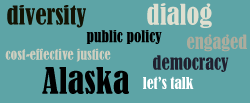FAIRBANKS — For 35 years, former state Sen. Rick Halford said, Alaskans haven’t worried much about how to pay for state government.
But that has to change, he told more than 200 Alaskans who gathered at the University of Alaska Fairbanks Friday night at the opening of a three-day event to discuss how Alaska can deal with a new era of reduced revenue brought on by long-term oil production declines and a more drastic drop in oil prices since last fall.
“We’ve spent the last 35 years often ordering at wonderful restaurants with no prices on the menu,” said Halford, who co-chaired the transition team for Gov. Bill Walker and Lt. Gov. Byron Mallott with Ana Hoffman. “Today, we’re not just asking people what do they want, but we have to ask, ‘What are you willing to pay for?’”
“That’s obviously where we’re going,” he said.
Halford and others who spoke at the opening dinner advised the members of the Walker-Mallott transition team and dozens of other participants from across the state to use the weekend to begin the process of adapting to the new reality of reduced revenue. Mallott set the stage by saying Alaska may go one of two directions in the future.
“We will either be a state in which we believe that we can be a society divided and still somehow make progress,” he said, or we can be a society in which people know they can disagree but “come together to make the decisions that build a better Alaska for every single one of us.”
Walker, meanwhile, said that many people regard the challenge facing Alaska as a statistical one that can be reduced to charts and graphs.
“Some people see numbers and dollar signs, I see faces. I see faces of children, of grandchildren,” Walker said.
He said he and Mallott have been scrambling since the election last fall with the drop in oil prices, and that the discussion needs to expand and consider the many options facing the state.
Earlier Friday, Walker took part in an event in North Pole at which he heated up and fused together two pieces of plastic pipe as a ceremonial start for the Fairbanks natural gas utility. He brought the black, high-density pipe to UAF and held it up for the crowd.
“We want to bring Alaska together,” he said. “The deal is, we do need to come together. We do need to talk to each other. We need to stop talking past each other, we need to talk amongst ourselves about what the solutions are.”

